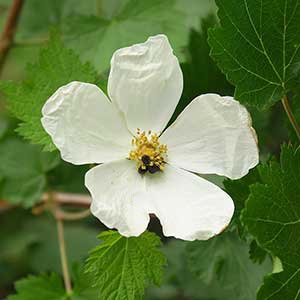|
|
strawberry bramble, strawberry-leaf raspberry
|
|
Mat-forming, unarmed perennial, the stems herbaceous, stolonous, rooting at the nodes; flowering stems erect, short, up to 2 cm. tall, with 1-3 leaves. |
|
Leaves with prominent, brownish, entire stipules, the blades long-petiolate, palmately divided into 5 leaflets; leaflets obovate, doubly serrate, 1-3 cm. long. |
|
Flowers solitary on filiform peduncles 2-6 cm. long; calyx nearly glabrous, the 5 lobes narrowly oblong-lanceolate, 5-11 mm. long, toothed near the tip; petals 5, white, oblong, equaling the sepals; stamens numerous; pistils 3-6, glabrous. |
|
Drupelets red, somewhat coherent; seeds 4 mm. long. |
|
|
Rubus bartonianus |
|
|
May-July |
|
Moist areas, open banks to dense forests, near sea level to timberline |
|
|
Occurring on both sides of the Cascades crest in Washington; Alaska to Oregon, east to Alberta, Idaho, and Montana.
|
|
Native |
|
Not of concern |
R. allegheniensis, R. arcticus, R. bifrons, R. idaeus, R. laciniatus, R. lasiococcus, R. leucodermis, R. nigerrimus, R. nivalis, R. parviflorus, R. pedatus, R. pensilvanicus, R. pubescens, R. spectabilis, R. ulmifolius, R. ursinus, R. vestitus |
R. allegheniensis, R. arcticus, R. bifrons, R. idaeus, R. laciniatus, R. lasiococcus, R. leucodermis, R. nigerrimus, R. nivalis, R. parviflorus, R. pensilvanicus, R. pubescens, R. spectabilis, R. ulmifolius, R. ursinus, R. vestitus |
| |



